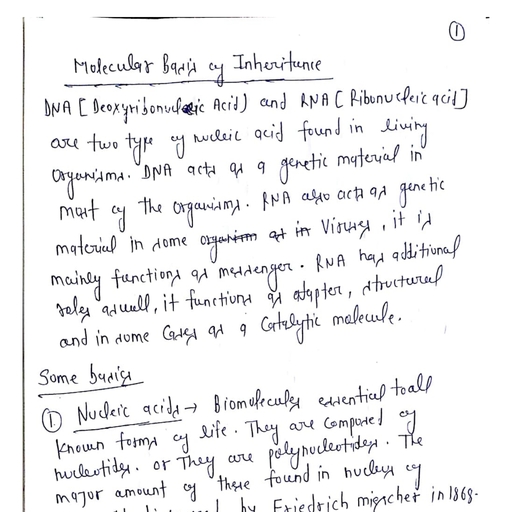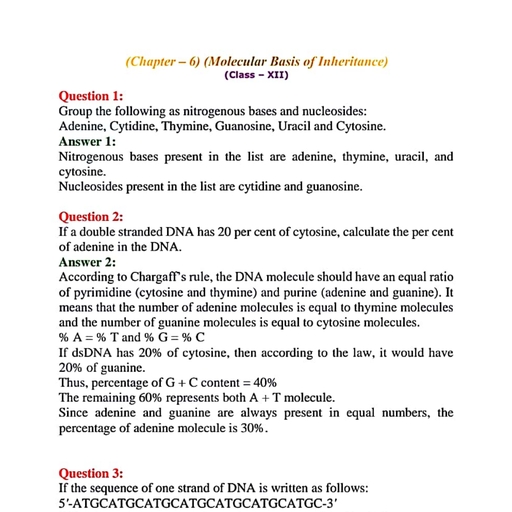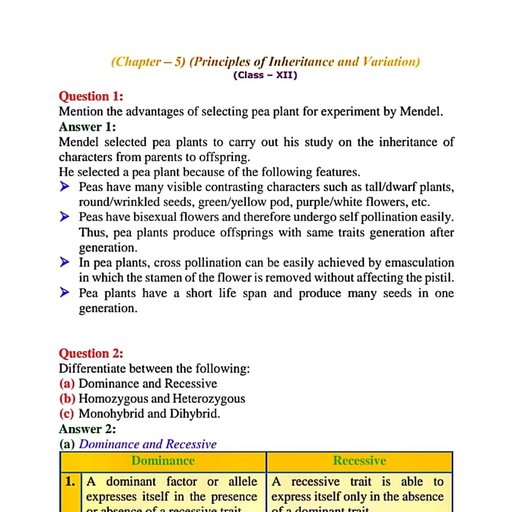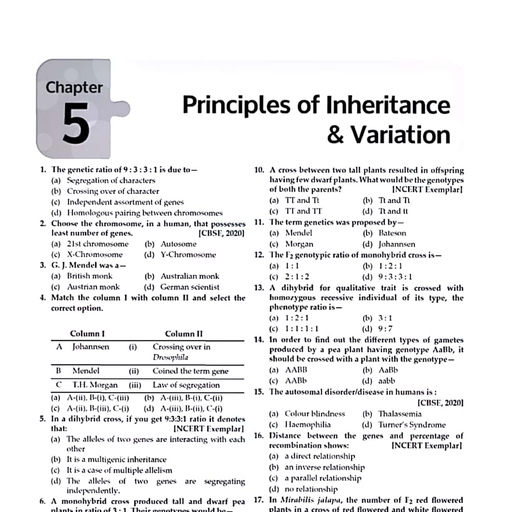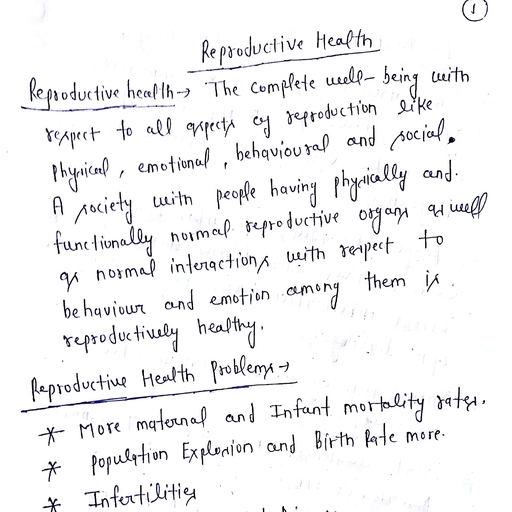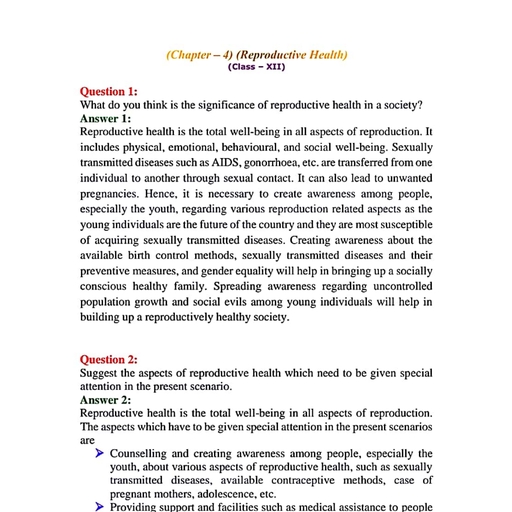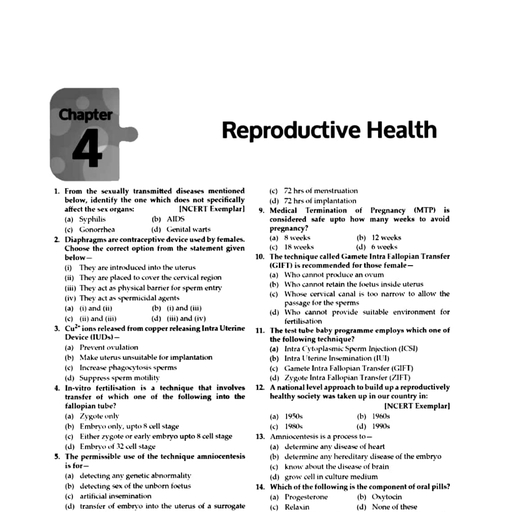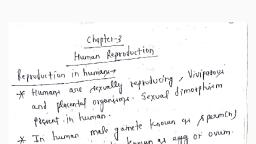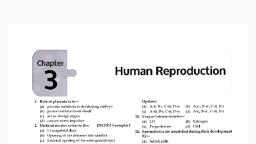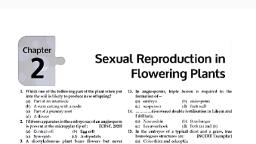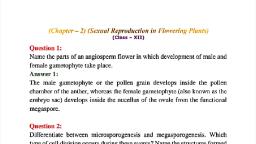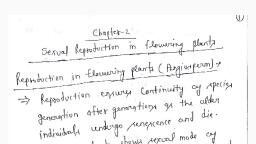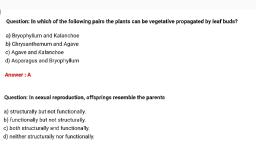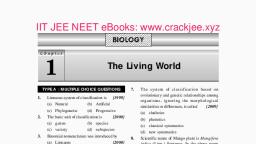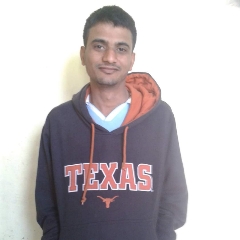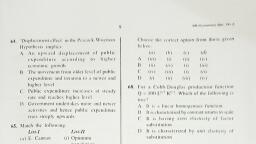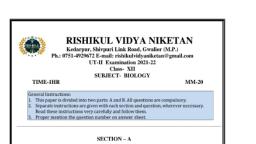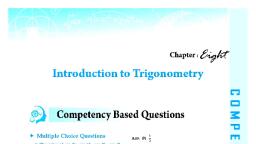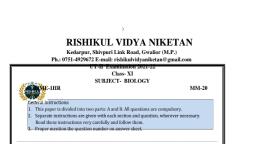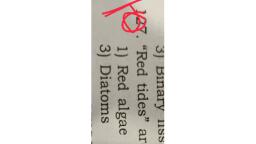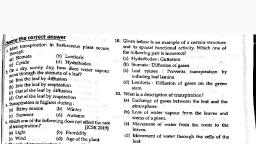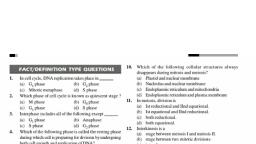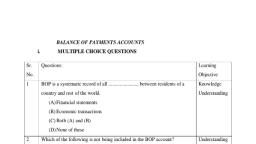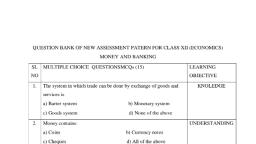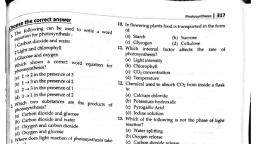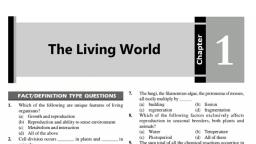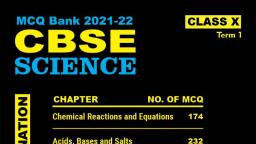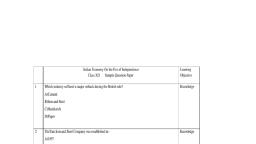Page 1 :
Chapter, Human Reproduction, 3., 1. Role of placenta is to-, (a) provide nutrition to developing embryo, (b) protect embryo from shock, (c) act as storage organ, (d) convey nerve impulses, 2. Urethral meatus refers to the:, Options:, (a) A-ii, B-i, C-iii, D-iv, (c) A-iii, B-i, C-ii, D-iv, 11. Corpus luteum secretes-, (b) A-iii, B-iv, C-ii, D-i, (d) A-ii, B-iv, C-iii, D-i, (b) Estrogen, (d) FSH, (a) LH, INCERT Exemplar], (c) Progesterone, 12. Spermatozoa are nourished during their development, by-, (a) Urinogenital duct, (b) Opening of vas deferens into urethra, (c) External opening of the urinogenital duct, (d) Muscles surrounding the urinogenital duct, 3. Clitoris in females is-, (a) Sertoli cells, (b) Interstitial cells, (c) Connective tissue cells, (d) None of the above, (a) homologous to penis, (b) analogous to penis, (c) functional penis in female, (d) non-functional, 4. Egg is liberated from ovary in-, (a) secondary Oocyte stage, (b) primary oxyte stage, (c) oogonial stage, (d) mature ovum stage, 5. Site of fertilisation in human beings is-, (a) ovary, (c) vagina, 6. Location and secretion of leydig cells are-, (a) Liver-cholesterol, (c) Testis-testosterone, 7. Which of the following is primary sex organ?, 13. Sperms produce an enzymatic substance for, dissolving egg membrane called-, (a) Hyaluronic acid, (c) Androgen, 14. In uterus, endometrium increases in thickness in, response to-, (a) Oxytocin, (c) LH, 15. Which of the following is immortal?, (b) Hyaluronidase, (d) Estrogen, (b) Estrogen, (d) Relaxin, (b) uterus, (d) fallopian tube, (a) Somatic cell, (c) Germ cell, 16. The spermatogonia undergo division to produce, sperms by the process of spermatogenesis. Choose the, correct one with reference to above., (b) Glomerular cell, (d) Cells of pituitary, (b) Ovary-estrogen, (d) Pancreas-glucagon, (a) Scrotum, (c) Testis, 8. In 28 days of human ovarian cycle, ovulation occurs, (b) Penis, (d) Prostate, INCERT Exemplar], (a) Spermatogonia have 46 chromosomes and always, undergo meiotic cell division, (b) Primary spermatocytes divide by mitotic cell, division, on-, (a) Day 1, (c) Day 14/15, 9. Prostate gland is present-, (b) Day 5, (d) Day 28, (c) Secondary spermatocytes have 23 chromosomes, and undergo second meiotic division, (d) Spermatozoa are transformed into spermatids, 17. The embryo at 16 celled stage is known as -, (b) on kidney, (d) around urethra, (a) on ureter, (c) on testis, 10. Match the following and choose the correct options:, [NCERT Exemplar], (b) Gastrula, (d) Blastomere, (a) Morula, (c) Blastula, 18. Amniocentesis is a technique used to-, Column I, Column II, (A) Trophoblast, (i), Embedding of blastocyst, (a) Determine errors in amino acid metabolism in, embryo, (b) Pinpoint specific cardiac ailments in embryo, (c) Determine any hereditary or genelic abnormality, in embryo, (d) All of the above, in the endometrium, (ii) Group of cells that would, differentiate as embryo, (B) Cleavage, (C) Inner cell mass (iii) Outer layer of blastocyst, the, attached, to, 19. 1st polar body is formed at which stage of oogenesis-, (a) Ist meiosis, (c) Ist mitosis, endometrium, (b) 2nd mitosis, (d) Differentiation, (D) Implantation, (iv) Mitotic division of zygote, Scanned by CamScanner
Page 2 :
20. Which layer develops first during embryonic, development?, (a) Ectoderm, (c) Endoderm, 21. A change in the amount of yolk and its distribution in, the egg will affect-, (a) Fertilisation, (b) Formation of zygote, (c) Pattern of cleavage, (d) Number of blastomeres produced, 22. Which among the following has 23 chromosomes?, (a) Spermatogonia, (c) Secondary oocyte, 23. The Leydig cells found in the human body are the, secretory source of-, (a) Progesterone, (c) Glucagon, 24. Seminal plasma, the fluid part of semen, is contributed, by., (i) Seminal vesicle, (iii) Urethra, (a) (i) and (ii), Column I, Column II, (A) Head, (B) Middle piece, (C) Acrosome, (D) Tail, Options:, (a) A-ii, B-iv, C-i, D-iii, (c) A-iv, B-i, C-ii, D-iii, 33. Corpus luteum develops from-, (a) Oocyte, (b) Nephrostome, (c) Ruptured Graafian follicle, (d) None of the above, 34. Graafian follicles are found in-, (i) Enzymes, (ii) Sperm motility, (iii) Energy, (iv) Genetic material, (b) Mesoderm, (d) Both (b) and (c), (b) A-iv, B-iii, C-i, D-ii, (d) A-ii, B-i, C-iii, D-iv, (b) Zygote, (d) Oogonia, (b) ovary of frog, (d) ovary of mammals, (a) testis of mammal, (b) Intestinal mucus, (c) ovary of cockroach, 35. Identify the odd one from the following:, (d) Androgens, INCERT Exemplar], INCERT Exemplar], (ii) Prostate gland, (iv) Bulbourethral gland, (a) Labia minora, (c) Infundibulum, 36. Find the odd one out., (b) Fimbriae, (d) Isthmus, (b) (i), (ii) and (iv), (d) (i) and (iv), (b) Mons pubis, (d) Labia majora, (a) Clitoris, (c) (ii), (iii) and (iv), 25. Signals for parturition originate from-, (a) Both placenta as well as fully developed foetus, (b) Oxytocin released from maternal pituitary, (c) P'lacenta only, (d) Fully developed foetus only, 26. In the absence of acrosome, the sperm-, (c) Lactiferous duct, 37. The nutritive cells found in seminiferous tubules are:, (b) Sertoli cells, (d) chorionic villi, (a) placenta, (c) Leydig's cells, 38. Select the feature of human female., (a) Well-developed mammary glands, (b) High-pitched voice, (c) Strong muscles, (d) Both (a) and (b), 39. Match the structures of male reproductive system, given in column I with their features given in column, Il and select the correct match from the options given, (a) Cannot get food, (b) Cannot swim, (c) Cannot penetrate the egg, (d) Cannot get energy, 27. What is present in the middle piece of sperm?, below., (a) Acrosome, (b) Mitochondria, (c) Nucleus, 28. Hormone responsible for the secretion of milk after, parturition is-, (d) Proximal centriole, Column I, Column II, (Structures), (Features), A Rete testis, (i), Facilitates insemination, (a) ICSH, (b) Prolactin, B Leydig cells (ii) Meiosis and sperm formation, (c) ACTH, (d) LH, 29. Gastrulation involves the differentiation of-, C Seminiferous (iii) Connects seminiferous, (a) ectoderm and endoderm, tubules, tubules to vasa efferentia, D Penis, (b) ectoderm, endoderm and mesoderm, (c) ectoderm and mesoderm, (iv) Secrete androgens, (a) A-(ii), B-(i), C-(iii), D-(iv), (d) mesoderm and endoderm, (b) A-(iii), B-(iv), C-(ii), D-(i), 30. About which day in a normal human menstrual cycle, does rapid secretion of LII (popularly called LH, surge) normally occurs?, (a) 14th day, (c) 5th day, 31. Sertoli cells are regulated by the pituitary hormone, known as-, (c) A-(iii), B-(i), C-(ii), D-(iv), (d) A-(ii), B-(iv), C-(iii), D-(i), 40. The seminal plasma is rich in:, (a) fructose and certain enzymes but it has low, calcium., (b) 20th day, (d) 1lth day, (b) glucose and certain enzymes but it has no calcium., (c) fructose and calcium but it has no enzymes., (d) fructose, calcium, and certain enzymes., 41. The given figure depicts a diagrammatic sectional, view of the human female reproductive system. Select, the option with correctly identified parts., (b) FSH, (d) Prolactin, (a) LH, (c) GH, 32. Match between the following representing parts of, the sperm and their functions and choose the correct, option., [NCERT Exemplar], Scanned by CamScanner
Page 3 :
50. Assertion: The myometrium undergoes cyclical, changes during menstrual cycle., Reason: The endometrium exhibits strong contractions, during delivery of the baby., 51. Assertion: The sex of the baby is determined by the, father and not by the mother., B, Reason: 50% of sperms carry the sex chromosome X, while the other 50% carry the sex chromosome Y., 52. Assertion: Progesterone is essential for maintenance of, the endometrium., G, (a) A-Ovary, G- Vagina, D - Fimbriae, (b) B-Isthmus, 1- vagina, F-Perimetrium, (c) L - Endometrium, H - Cervical canal, C-, Ampulla, (d) E - Infundibulum, J, Myometrium, Reason: Endometrium is essential for implantation of, embryo., 53. Assertion: All copulations do not lead to fertilisation, and pregnancy., Reason:Fertilisation can only occur if the ovum, and sperms are transported simultaneously to the, ampullary- isthmic junction., 54. Assertion: Corpus luteum is produced by Graafian, follicle after ovulation., Endometrium, K, 42. The part of the sperm that plays an important role in, penetrating the egg membrane is:, Reason: It secretes oestrogen which is necessary to, maintain pregnancy., (a) tail, (b) middle piece, (c) nucleus, 43. The phase of menstrual cycle when ovulation occurs is:, (a) proliferative phase, (c) menstrual phase, 44. Cleavage of zygote forms 2, 4, 6, 8, and 16 cells. These, cells are called:, (d) acrosome, 55. Assertion: During pregnancy, development of foetus, occurs in stages., Reason: In second month of pregnancy, limbs, most of, the organs and external genitalia are formed., 56. Read the following and answer any four questions, from 56 (i) to 56 (v) given below:, Adolescence is the period of dramatic physical and, psychological changes in a person. An adolescent, person is at high risk, or alcohol abuse. Common causes are; curiosity,, excitement, experimentation, etc. Drugs are frequently, used because of their perceived benefits. The inherent, addictive nature of these substances results in addiction, (b) secretory phase, (d) None of these, (a) morula, (b) inner cell mass, (c) blastomeres, 45. hCG, hPL, and relaxin are produced in women:, (d) None of these, falling in the trap of drug, (a) during menstruation, (b) at the time of menopause, (c) only during pregnancy, (d) at the time of puberty, and dependence. Addiction is a psychological, attachment to various effects of a substance. So, a person, Directions: In the following questions, a statement, of assertion is followed by a statement of reason., Mark the correct choice as:, continues to lake addictive substance even when he, does not need it in the real sense. Tolerance level of the, (a) If both assertion and reason are true and reason, is the correct explanation of assertion., (b) If both assertion and reason are true, but reason, is not the correct explanation of assertion., receptors ion our body increases with repeated use of, addictive substances. This results in body craving for, higher doses. Long term consequences of addiction can, be highly devastating. P'arents and teachers should take, responsibility to identify situations which may trigger, unwanted belhaviour. Parents and teachers should instil, If assertion is true, but reason is false., If assertion is false but reason is true., (c), self-discipline adolescent persons. l'eer pressure should, be avoided at all cost. Proper steps should be taken to, increase awareness. If the need arises, then professional, help should also be taken., (i) Nicotine acts as a stimulant because it mimics the, effect of:, (d), 46. Assertion: Infundibulum is a funnel-shaped part closer, to ovary., Reason: The edges of infundibulum helps in collection, of the ovum after ovulation., 47. Assertion: The shape of the uterus is like an inverted, реar., Reason: The uterus opens into vagina through a narrow, (a) Thyroxine, (c) Testosterone, (ii) Continuous use of alcohol causes:, (b) Acetylcholine, (d) Dopamine, cervix., (a) Gastritis, (b) Neuritis, 48. Assertion: Each testicular lobule has 1-4 tightly coiled, seminiferous tubules., Reason: Seminiferous tubules are lined by two distinct, populations of cells., 49. Assertion: The bulbourethral gland is a male accessory, gland., Reason: The secretions of bulbourethral glands helps in, the lubrication of the penis., (c) Swelling of liver, (d) All of the above, (iii) Tobacco inhalation causes:, (a) Stimulation of nerve induction and cough, depressant., (b) Heart diseases and low blood pressure., Scanned by CamScanner
Page 4 :
(c) Inhibits the oxygen carrying capacity, and increases the more transportation of, CO2., (d) Nerve stimulation, heart diseases, decrease, in Oz carrying capacity, lung cancer, chronic, bronchitis etc., 2. relatively high number of mitochondria, 3. presence of acrosome, 4. Stores relatively high energy, (b) 1 and 4, (d) 3 and 4, (a) 1 and 2, (c) 2 and 3, (ii) The vas deferens receives duct from the seminal, (iv) Tunnel vision is caused by:, (a) Drug addiction (b) Use of tobacco, (c) Use of alcohol, vesicle and opens into urethra as:, (a) epididymis, (c) efferent duct, (b) ejaculatory duct, (d) ureter, (d) Use of alcohol, (v), (iii) In spermatogenesis, reduction division occurs, during conversion of:, Luk, 29.3, (a) spermatogonia, spermatocytes., (b) spermatids to sperms., to, primary, 22.3, 18.4 18-4, 7-9, 6-6, (c) primary, spermatocytes., 5.7, spermatocytes, to, secondary, 10th, Grade, IAlcohol OCigarettes Marijuana, 8th, 12th, (d) secondary spermatocytes to spermatids., (iv) The mature sperms are stored in the:, (a) Seminiferous tubules, The following statements are drawn as conclusions, from the above data:, (b) Vas deferens, I. Grade 12h students are more likely to consume, alcohol compared to Marijuana., II. Grade 10h students consume both alcohol and, marijuana in equal proportions., III. As adolescents get older, they tend to drink more., IV. Drinking alcohol can cause kids to have accidents, and get hurt., (c) Epididymis, (d) Seminal vesicle, (v) Assertion: The urethra is the terminal portion of, the male reproductive system., Reason: The urelhra extends through the penis by, an external opening called urethral meatus and is, used to convey both urine and semen at different, times., (a) Both assertion (A) and reason (R) are true,, and reason (R) is the correct explanation of, Choose from below the correct alternative., (a) Only I is true, (b) I, Il and IIl are true, (c) III and II are true, (d) I and II are true, assertion (A)., (b) Both assertion (A) and reason (R) are true, but, reason (R) is not the correct explanation of, assertion (A)., (c) Assertion (A) is true but reason (R) is false., 57. Read the following and answer any four questions, from 57 (i) to 57 (v) given below:, The main structures of the male reproductive system, are located external to the body. The two testes, (singular, testis) hang between the thighs in a sac, of skin calledl the scrotum. The testes produce both, sperm and testosterone. Resting on top of each, testis is a coiled structure called the epididymis. The, function of the epididymis is to mature and store, sperm. The penis is a tubular organ that contains the, urethra and has the ability to stiffen during sexual, arousal. Sperm passes out of the body through the, urethra during a sexual climax. In addition to these, organs, there are several ducts and glands that are, internal to the body. At the time of ejaculation, the, sperm are transported through the 'vas deferens', and fluid is added to the sperm from various glands,, including the prostate and seminal vesicles during, their journey. This mixture of secretions is known as, (d) Assertion (A) is false but reason (R) is true., 58. Read the following and answer any four questions, from 58 (i) to 58 (v) given below:, Parturition is the completion of pregnancy and giving, birth to the baby. The series of events that expels the, infant from the uterus is collectively called "labour"., Throughout pregnancy, the uterus undergoes periodic, episodes of weak and strong contractions. As the, pregnancy progresses, increase in the oestrogen, concentration promotes uterine contractions. These, uterine contractions facilitate downward movement of, the foetus. The descent of the foctus causes dilation of, cervix of the uterus and vaginal canal resulting in foetal, ejection reflex. This initiates the secretion of oxytocin, from the neurohypophysis which in turn brings about, the powerful contraction of the uterine muscles and, leads to the expulsion of the baby through the birth, canal., (i) Foetal ejection reflex in human female is induced, by:, (a) Release of oxytocin from pituitary, (b) Pressure exerted by amniotic fluid, (c) Differentiation of mammary glands, (d) Fully developed foetus and placenta, semen., (i) What are two adaptive features of a human sperm, cell?, 1. presence of jelly coat, Scanned by CamScanner
Page 5 :
(ii) Scientifically, the delivery of the developed fetus, is termed as:, (i) Portion of placenta contributed by the embryo is, the, (a) Chorion, (c) Amnion, (ii) Which hormone produced by the placenta causes, the mother's pubic symphysis to loosen and, (a) ovulation, (b) abortion, (b) Yolk sac, (c) parturition, (d) oviposition, (d) Allantois, (iii) Vigorous contractions of the uterus during, parturition are induced by:, widen?, (a) neuroendocrine mechanism, (a) FSH, (c) Estrogen, (iii) Finger like outgrowth in surface of blastocysts:, (a) implantation, (c) placenta, (iv) Which one of the following hormones is not, secreted in any human chorionic placenta?, (a) Progesterone/pregnancy hormone, (b) Estrogen and hPL, (c) Prolactin, (b) progesterone, (d) relaxin, (b) endocrine mechanism, (c) embryo pushing out, (b) chorion, (d) chorionic villi, (d) uterine fluids, (iv) What is the correct sequence for parturition to, occur?, (a) Signal from fetus and placenta Uterine, contractions - Release of oxytocin - Rise in, oxytocin secretionPowerful contractions→, Parturition, (b) Uterine contractions - Release of oxytocin, -» Rise in oxytocin secretion - Powerful, contractions - Signal from fetus and placenta, (d) hCG, (v) Select the unpaired structure in male., (a) Epididymis, (c) Urethra, (b) Ejaculatory duct, (d) Vas deferens, -» Parturition, 60. Read the following and answer any four questions, from 60 (i) to 60 (v) given below:, At the start of the menstrual cycle, the lining of the, uterus wall breaks down. As each follicle in the ovaries, develops, the amount of oestrogen produced by the, ovary increases. The oestrogen act on the uterus and, cause its lining to become thicker and develop more, blood vessels. These are changes that help an early, embryo to implant. Two hormones, follicle-stimulating, hormone (FSH) and luteinising hormone (LH) promote, ovulation. Once the ovum has been released, the, follicle that produced it develops into a solid body, called the corpus luteum. This produces a hormone, called progesterone, which affects the uterus lining, in the same way as the oestrogens, making it grow, thicker and produce more blood vessels. If the ovum, is fertilised, the corpus luteum continues to release, progesterone and so keeps the uterus in a state suitable, for implantation. If the ovum is not fertilised, the corpus, luteum stops producing progesterone. As a result, the, thickened lining of the uterus breaks down and loses, blood, which escapes through the cervix and vagina., (i) Which hormone maintains the thickness of the, (c) Signal from felus and placenta → Release of, oxytocin -→ Uterine contractions → Rise in, oxytocin secretion Powerful contractions ->, Parturition, (d) Release of oxytocin - Uterine contractions, → Signal from fetus and placenta - Rise in, oxytocin secretion - Powerful contractions ->, Parturition, (v) Assertion: The series of events that expels the, infant from the uterus is collectively called, "labour"., Reason: At theend of gestation period, the maternal, pituitary releases prolactin which causes uterine, contraction., (a) Both assertion (A) and reason (R) are true,, and reason (R) is the correct explanation of, assertion (A)., (b) Both assertion (A) and reason (R) are true, but, reason (R) is not the correct explanation of, assertion (A., (c) Assertion (A) is true but reason (R) is false., (d) Assertion (A) is false but reason (R) is true., lining of the uterus during pregnancy?, (a) follicle stimulating hormone (FSH), (b) luteinising hormone (LH), (c) oestrogen, (d) progesterone, (ii) The graph shows a hormone that is involved in, controlling the human female menstrual cycle., 59. Read the following and answer any four questions, from 59 (i) to 59 (v) given below:, During pregnancy, the placenta acts as a temporary, endocrine gland and produces large quantities of, human Chorionic Gonadotropin (hCG), human, Placental Lactogen (hlPL), oestrogen and progesterone, which are essential for a normal pregnancy.A hormone, called relaxin is also secreted during the later phase, of pregnancy which helps in relaxation of the pelvic, ligaments at the time of parturition. It should be noted, that hCG, hl'I. and relaxin are produced only during, pregnancy. In addition, during pregnancy the level, of other hormones like oestrogen and progesterone,, cortisol, prolactin, thyroxine, etc., is increased several, folds in the maternal blood. These hormones are, concentration, of hormone, 14, 28, time/days, essential for supporting foetal growth., Scanned by CamScanner



